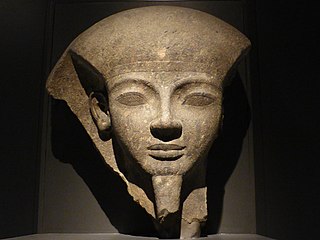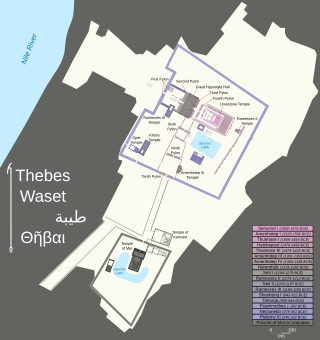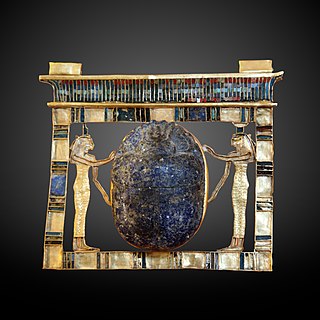Related Research Articles

Thebes, known to the ancient Egyptians as Waset, was an ancient Egyptian city located along the Nile about 800 kilometers (500 mi) south of the Mediterranean. Its ruins lie within the modern Egyptian city of Luxor. Thebes was the main city of the fourth Upper Egyptian nome and was the capital of Egypt for long periods during the Middle Kingdom and New Kingdom eras. It was close to Nubia and the Eastern Desert, with its valuable mineral resources and trade routes. It was a religious center and the most venerated city during many periods of ancient Egyptian history. The site of Thebes includes areas on both the eastern bank of the Nile, where the temples of Karnak and Luxor stand and where the city was situated; and the western bank, where a necropolis of large private and royal cemeteries and funerary complexes can be found. In 1979, the ruins of ancient Thebes were classified by UNESCO as a World Heritage Site.

The Karnak Temple Complex, commonly known as Karnak, comprises a vast mix of temples, pylons, chapels, and other buildings near Luxor, Egypt. Construction at the complex began during the reign of Senusret I in the Middle Kingdom and continued into the Ptolemaic Kingdom, although most of the extant buildings date from the New Kingdom. The area around Karnak was the ancient Egyptian Ipet-isut and the main place of worship of the 18th Dynastic Theban Triad, with the god Amun as its head. It is part of the monumental city of Thebes, and in 1979 it was added to the UNESCO World Heritage List along with the rest of the city. The Karnak complex gives its name to the nearby, and partly surrounded, modern village of El-Karnak, 2.5 kilometres north of Luxor.

Menmaatre Seti I was the second pharaoh of the Nineteenth Dynasty of Egypt during the New Kingdom period, ruling c. 1294 or 1290 BCE to 1279 BCE. He was the son of Ramesses I and Sitre, and the father of Ramesses II.

Menpehtyre Ramesses I was the founding pharaoh of ancient Egypt's 19th Dynasty. The dates for his short reign are not completely known but the timeline of late 1292–1290 BC is frequently cited as well as 1295–1294 BC. While Ramesses I was the founder of the 19th Dynasty, his brief reign mainly serves to mark the transition between the reign of Horemheb, who had stabilized Egypt in the late 18th Dynasty, and the rule of the powerful pharaohs of his own dynasty, in particular his son Seti I, and grandson Ramesses II.

The New Kingdom, also referred to as the Egyptian Empire, was the ancient Egyptian nation between the 16th century BC and the 11th century BC. This period of ancient Egyptian history covers the Eighteenth, Nineteenth, and Twentieth Dynasties. Through radiocarbon dating, the establishment of the New Kingdom has been placed between 1570 BC and 1544 BC. The New Kingdom followed the Second Intermediate Period and was succeeded by the Third Intermediate Period. It was the most prosperous time for the Egyptian people and marked the peak of Egypt's power.

Merneptah or Merenptah was the fourth pharaoh of the Nineteenth Dynasty of Ancient Egypt. He ruled Egypt for almost ten years, from late July or early August 1213 BC until his death on 2 May 1203 BC, according to contemporary historical records. He was the first royal-born pharaoh since Tutankhamun of the Eighteenth Dynasty.

Ramesses VI Nebmaatre-Meryamun was the fifth ruler of the Twentieth Dynasty of Egypt. He reigned for about eight years in the mid-to-late 12th century BC and was a son of Ramesses III and queen Iset Ta-Hemdjert. As a prince, he was known as Ramesses Amunherkhepeshef and held the titles of royal scribe and cavalry general. He was succeeded by his son, Ramesses VII Itamun, whom he had fathered with queen Nubkhesbed.

Bintanath was the firstborn daughter and later Great Royal Wife of the Egyptian Pharaoh Ramesses II.
Peter FitzGerald Dorman is an epigrapher, philologist, and Egyptologist. Recently a professor of history and archaeology at the American University of Beirut (AUB), he served as the 15th President of the university from 2008 to 2015. He spent most of his career as a professor and chair in the department of Near Eastern Languages and Civilizations (NELC) of the University of Chicago, and was director of Chicago House in Luxor, the Epigraphic Survey field project of the Oriental Institute. He is presently a professor emeritus of the University of Chicago.

The Precinct of Amun-Re, located near Luxor, Egypt, is one of the four main temple enclosures that make up the immense Karnak Temple Complex. The precinct is by far the largest of these and the only one that is open to the general public. The temple complex is dedicated to the principal god of the Theban Triad, Amun, in the form of Amun-Re.

The Temple of Ramesses III at Medinet Habu was an important New Kingdom period temple structure in the West Bank of Luxor in Egypt. Aside from its size and architectural and artistic importance, the mortuary temple is probably best known as the source of inscribed reliefs depicting the advent and defeat of the Sea Peoples during the reign of Ramesses III.

Gebel el-Silsila or Gebel Silsileh is 65 km (40 mi) north of Aswan in Upper Egypt, where the cliffs on both sides close to the narrowest point along the length of the entire Nile. The location is between Edfu in the north towards Lower Egypt and Kom Ombo in the south towards Upper Egypt. The name Kheny means "The Place of Rowing". It was used as a major quarry site on both sides of the Nile from at least the 18th Dynasty to Greco-Roman times. Silsila is famous for its New Kingdom stelai and cenotaphs.

The Great Hypostyle Hall is located within the Karnak Temple Complex, in the Precinct of Amon-Re. It is one of the most visited monuments of Ancient Egypt. The structure was built around the 19th Egyptian Dynasty. Its design was initially instituted by Hatshepsut, at the North-west chapel to Amun in the upper terrace of Deir el-Bahri. The name refers to hypostyle architectural pattern.

Takhat was an ancient Egyptian princess and queen of the 19th Dynasty, the mother of the usurper pharaoh Amenmesse.

The history of the Karnak Temple complex is largely the history of Thebes. The city does not appear to have been of any significance before the Eleventh Dynasty, and any temple building here would have been relatively small and unimportant, with any shrines being dedicated to the early god of Thebes, Montu. The earliest artifact found in the area of the temple is a small, eight-sided column from the Eleventh Dynasty, which mentions Amun-Re. The tomb of Intef II mentions a 'house of Amun', which implies some structure, whether a shrine or a small temple is unknown. The ancient name for Karnak, Ipet-Isut only really refers to the central core structures of the Precinct of Amun-Re, and was in use as early as the 11th Dynasty, again implying the presence of some form of temple before the Middle Kingdom expansion.

The Temple of Khonsu is an ancient Egyptian temple. It is located within the large Precinct of Amun-Re at Karnak, in Luxor, Egypt. The edifice is an example of an almost complete New Kingdom temple, and was originally constructed by Ramesses III on the site of an earlier temple. The gateway of this temple is at the end of the avenue of sphinxes that ran to the Luxor Temple. In Ptolemaic times, Ptolemy III Euergetes constructed a great gateway and enclosure wall for the temple; only the gateway now remains. Inscriptions inside the forecourt of the temple were made in the time of Herihor.

Paser was an ancient Egyptian noble who served as vizier during the reigns of Seti I and Ramesses II in the 19th Dynasty. He would later also become High Priest of Amun.

Ramesses II, commonly known as Ramesses the Great, was an Egyptian pharaoh. He was the third ruler of the Nineteenth Dynasty. Along with Thutmose III of the Eighteenth Dynasty, he is often regarded as the greatest, most celebrated, and most powerful pharaoh of the New Kingdom, which itself was the most powerful period of ancient Egypt. He is also widely considered one of ancient Egypt's most successful warrior pharaohs, conducting no fewer than 15 military campaigns, all resulting in victories, excluding the Battle of Kadesh, generally considered a stalemate.
Nebamun was a Vizier of Ancient Egypt. He served from about the reign of Horemheb to the reign of Ramesses II.

William Joseph Murnane was an American Egyptologist and author of a number of books and monographs on Ancient Egypt. He was director of the Great Hypostyle Hall Project at Luxor Karnak Temple, was a research associate and held a Dunavant Professorship in the History Department of the Institute of Egyptian Art & Archaeology at the University of Memphis. Several of his scholarly monographs are used as standard references by historians and philologists whilst more popular works, which drew on his considerable knowledge of Ancient Egyptian monuments, are used by tourists.
References
- ↑ The Monuments of Seti 1 and Their Historical Significance: Epigraphic, Art Historical and Historical Analysis University of Toronto 1998.
- ↑ Book William H. Peck, Book Review of "The Monuments of Seti I: Epigraphic, Historical, and Art Historical Analysis The Monuments of Seti I: Epigraphic, Historical, and Art Historical Analysis by Peter J. Brand", Journal of Near Eastern Studies, Vol. 64, No. 2 (April 2005), pp. 113–115
- ↑ The Great Karnak Hypostyle Hall Project
- ↑ "Causing His Name to Live: Studies in Egyptian Epigraphy and History in Memory of William J. Murnane"
- ↑ Usurped Cartouches of Merenptah at Karnak and Luxor